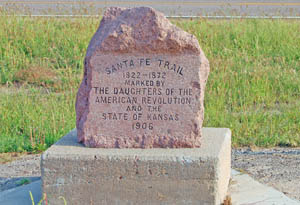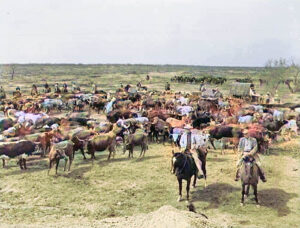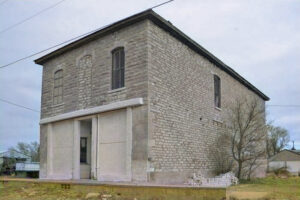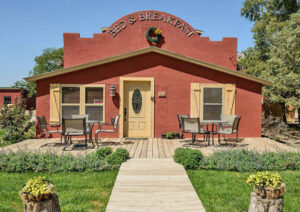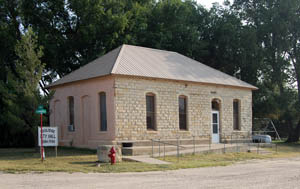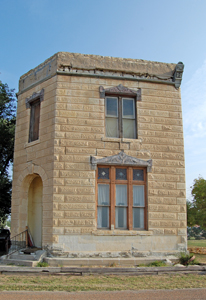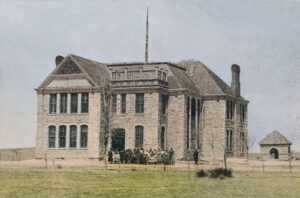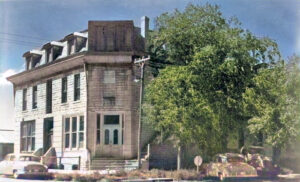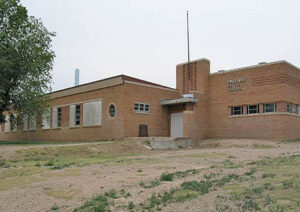Coolidge, Kansas, is a small town on the north bank of the Arkansas River in Hamilton County. As of the 2020 census, its population was 80, and its total area was 0.46 square miles, all land.
Long before the community was settled, Coolidge was a hub along the Santa Fe Trail during the mid-19th century.
The community started when a post office called Sargent was established on January 24, 1873. However, its life was brief; it closed on October 28 of the same year.
The Atchison, Topeka & Santa Fe Railroad was constructed through Hamilton County in 1871-72, and with it came a flurry of advertising encouraging Easterners to relocate to Kansas.
On December 10, 1877, the Sargent post office reopened.
This end-of-the-line town was born of the railroad. When the Atchison, Topeka & Santa Fe Railroad decided it wanted to expand westward into Colorado, it began looking for a site for its base of operations until the company had the necessary equipment to expand across the state line. It found that Sargent was the perfect location, as the track was already extended there. In 1881, the railroad division point was moved from Old Granada, Colorado, to Sargent. Here, crews would change and load up with coal, water, grease, and make repairs. This created the need for stores, stables, businesses, and other services. Before that time, the town had a post office, several saloons, and a few small buildings that housed railroad workers.
On July 5, 1881, the town and post office were renamed Coolidge, after T.J. Coolidge, the President of the Atchison, Topeka & Santa Fe Railroad.
By 1882, Coolidge had become a significant, growing, and popular Kansas town. The first school was built in 1885.
Coolidge’s peak years were from 1885 to 1887, when it enjoyed a massive cattle trade and a floating population of 800-1000.
The Harvey House was relocated from Lakin, Kansas, to Coolidge to provide food and housing for the 27-engine roundhouse. In the early 1880s, the railroad also built machine shops, passenger and freight depots, a hotel, and tenement housing. Soon afterward, about 100 other businesses and entrepreneurs flooded the community.
The local newspapers of the period vividly recall the excitement throughout the city as it strived to become the “most important railroad town in the upper Arkansas Valley.” Advertisements for builders, contractors, building materials, architects, hotels, restaurants, and shops lined the newspaper columns.
Coolidge was platted and became Hamilton County’s first incorporated city on February 7, 1886. One of the first substantial buildings and businesses was the Coolidge State Bank, which opened on April 26, 1886.
That year, local blacksmith and entrepreneur Garner T. Potter moved a building constructed in nearby Trail City, Colorado, to Coolidge. Built in 1885, it served as a saloon and gambling hall in the colorful cattle town, where historic cattle drives on the National Cattle Trail moved livestock to their northern grazing grounds.
Garner T. Potter moved the building to 110 Walnut Street in Coolidge, Kansas, in 1886. Potter’s Hall, also called Potter’s Opera House, was a two-story building, measuring 26 by 60 feet, of locally quarried limestone. When it was first established, the building served as a place for essential community functions, where churches held religious services and schoolchildren attended classes. A restaurant occupied its basement, the schoolroom was on the first floor, and the second floor had a stage and scenery.
As Potter’s Opera House was celebrating its opening, the newspaper boasted of local developer E.H. Peck’s plans for a bigger and costlier opera house at the corner of Coolidge and Main.
As other buildings were constructed, this building’s function shifted to that of a meeting hall, community center, and entertainment venue. It was once surrounded by other buildings of similar construction and character, including the significant Silver Star Hotel.
Potter’s Opera House is one of only a few commercial buildings from the city’s heyday in the mid-1880s. Today, it serves as the Trail City Bed and Breakfast, a luxurious western living experience.
The railroad had spent over $350,000 on improvements in Coolidge by the middle of 1887.
That year, E.H. Peck, who had considerable local influence, negotiated with the City of Coolidge to supply the town with water. On December 7, 1887, it was reported that the city council had voted to grant Peck a “franchise for a term of 50 years…for supplying our town with water.”
The town was caught up in and eventually lost a county-seat dispute with Syracuse in 1888.
Peck’s Magnificent Opera House was built that year for $75,000 and opened in July 1888. Unfortunately, just one month later, on August 25, 1888, the beautiful opera house building burned in a tragic fire.
That year, the one-story limestone City Hall with a hipped roof at 210 Wheeler Avenue was built.
The Italianate-style two-story Coolidge State Bank was also built at the northeast corner of Maple and Highway 50 (Coolidge Avenue). The rectangular native-stone corner building featured elaborate Greek Revival ornamentation, a flat roof, and two bank vaults. The building still stands today.
Also built in 1888 was a general store at the Northeast corner of Coolidge and Elm Streets. It still stands today.
At its peak, it had three lumber yards, three dry goods stores, five restaurants, and seven grocery stores. There were also several newspapers that kept track of the news of the area. Two large merchandising firms, Otero and Sellers, and Chick Brown and Company, were all located in Coolidge.
Coolidge’s tremendous building boom was beginning to wane by the late 1880s. In late 1888, the Masons regularly met at Potter’s Opera House, while its owner took in “a few dimes each evening by converting his hall into a skating rink.”
Between 1888 and 1891, the rail lines spurred the rapid growth of other towns, especially Syracuse, its nearby competitor.
Small construction projects were ongoing, but the business side saw many businesses leaving and relocating to Syracuse. The citizens could not deny that town growth had slowed dramatically.
Coolidge officials had been trying to increase the Atchison, Topeka & Santa Fe Railroad property taxes to help build the town’s funds. However, the railroad refused to comply with the demand for a tax increase, and the relationship between the two became very strained.
When a group of fed-up Coolidge residents vowed to get even, they chained a fully loaded locomotive to the tracks and would not allow it to pass through the town unless the railroad began paying taxes. As a result, the railroad officials issued a statement: “They were transferring their records to La Junta, Colorado, and moving the main division point to nearby Syracuse.” Coolidge residents didn’t believe the threat would be carried out until September 5, 1890, when it became a reality. About 500 employees were relocated out of Coolidg,e then, and the popular Harvey House was moved east to Syracuse. The railroad also moved the division point from Coolidge to La Junta, Colorado. It was a terrible blow for the community.
The highest census population for Coolidge was 472 in 1890.
The Masons purchased Potter’s building on July 1, 1892, and used the second floor for their lodge.
With the population decline, the 1890s were rough for Coolidge. Business owners’ sales declined; they had no one to sell their businesses to, and many went bankrupt. Other owners thought that if they burned their businesses and filed a claim with their insurance company, they would hopefully receive a payment and have the financial ability to move out of Coolidge. During that decade, fires burned nearly six blocks of the town. The few hundred remaining residents depended upon agriculture, and Coolidge became a grain storage depot along the railroad line.
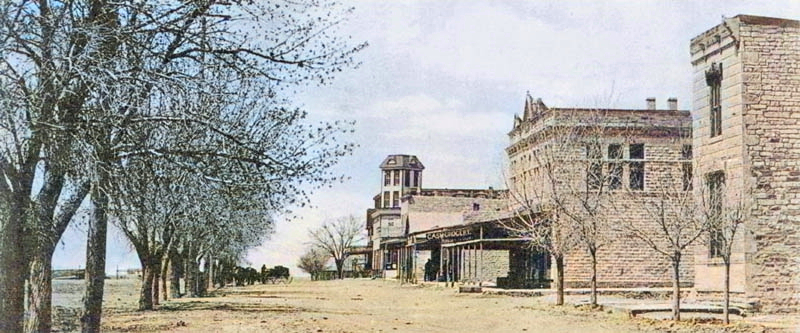
Main Street in Coolidge, Kansas, in about 1905.
In 1910, Coolidge was an incorporated city of the third class and was still a station on the Atchison, Topeka, and Santa Fe Railroad. At that time, it had several general stores, a weekly newspaper called the Leader, a hotel, an express and telegraph office, telephone communications, a graded public school, the leading church organizations, and a money order post office. However, that year, a town-wide fire destroyed more of the once-thriving town. Its population was 145.
This area was hit hard during the 1930s Dust Bowl but rebounded to a brief period of agricultural prosperity, as evidenced by the mid-century concrete grain elevators next to the railroad tracks.
In 1947, a new L-shaped brick school was built.
The old Silver Star Hotel was razed in the 1960s.
In 1962, a high school was constructed West of this school.
After the bank division point was moved to Syracuse in the 1960s, the building became the Coolidge Post Office. It has also served as an Odd Fellow Lodge, a grocery store, and the first Coolidge library. It was last used as a residence.
The schools closed in 1969. Grain is now stored in the auditorium, and the west building is used for town meetings and other events.
In 1985, Coolidge Mason Lodge #316 merged with the lodge in Syracuse, and they sold the Potter building on November 26, 1986.
Coolidge is a small farming community growing wheat, corn, and sugar beets today. A few surviving stone buildings from that period exist in Coolidge, including the City Hall, Potter’s Opera House, an old general store, and the old bank. However, there is no grocery store or a gas station.
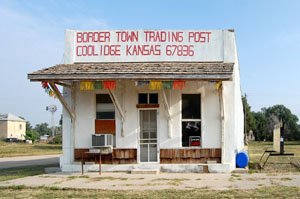
This old trading post in Coolidge, Kansas, was built as a general store in 1888. Photo by Kathy Alexander.
The community is served by the Syracuse USD 494 public school district, located in the city of Syracuse.
Coolidge is located along Highway 50, about two miles east of the Colorado-Kansas border and 14 miles west of Syracuse, the county seat.
©Kathy Alexander/Legends of Kansas, updated December 2025.
Also See:
Syracuse – Hamilton County Seat
Sources:
Barth, Tanner; Chapman Center for Rural Studies, Kansas State University, Spring, 2013.
Blackmar, Frank W.; Kansas: A Cyclopedia of State History, Vol I; Standard Publishing Company, Chicago, IL 1912.
Encyclopedia of Forlorn Places
Fort Hays State University
Kansas Historic Resources Inventory
Kansas State Register of Historic Places
Travel Kansas
Wikipedia


